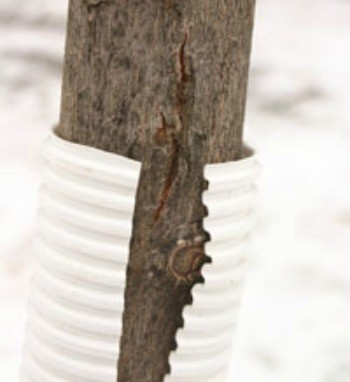
If you live in a climate where winters are severe, you've probably already discovered that the snow and cold weather can cause severe damage to trees and shrubs. And while you can't do anything about the weather, a little bit of planning and preparation can minimize the effects of winter damage on your landscaping.
On cold winter days, the low angle of the winter sun can heat up the bark enough to stimulate cellular activity. During the day, the bark tissue expands from the warmth of the sun, usually on its southwest side. As temperatures drop at sunset, the temperature of the trunk also drops rapidly. This causes elongated cracks or sunken or dried areas in the bark.
Prevention: Smooth or thin-barked trees (cherry, crabapple, honey locust, linden, maple, mountain ash, and several types of fruit trees) and young or newly planted trees are the most susceptible to "sun scald". You can prevent it by wrapping the trunk from the base to the first branch in commercial tree wrap. Plastic guards or other light colored material like white latex paint can also help deflect sunlight, helping the bark maintain a constant temperature.
Evergreen foliage may become bleached or turn brown due to loss of moisture, swings in temperature or the arrival of cold temperatures before trees and shrubs have had time to completely harden off.
Prevention: To minimize moisture loss, evergreens should be watered thoroughly going into late fall and early winter. This supplies roots with the moisture needed to make up what is lost through the foliage on windy days.
Bleaching damage commonly occurs on the southern side of the tree or shrub. If possible, plant them in areas where they are protected from wind and the sudden shifts in temperature due to daytime warming and sunset cooling.
Severe winter temperatures can cause shoot dieback and bud death in deciduous trees and shrubs.
Prevention: There is nothing you can do to guarantee protection from winter dieback, but there are a few measures to take to put the odds in your favor. Keeping plants healthy going into winter will make them less susceptible to cold temperature damage. This means avoiding late summer fertilizing and over watering or pruning. Plants that are not hardy to your climate should be planted in a protected area of your landscaping.
Roots are the last part of the tree or shrub to go dormant in the winter. Soil temperatures are usually warmer than air temperatures because soil cools more slowly than air. Roots are less hardy than stems and branches and can become severely damaged or die at temperatures below 10°F.
Prevention: Moist soil retains moisture longer than dry soil. Watering trees and shrubs well during the fall months will help prevent damaging frost from penetrating the soil to root levels. Mulch thoroughly in the fall to keep soil warm and give trees and shrubs extra time to devote to root growth before winter. Check around newly planted trees and shrubs for cracks in the soil and fill them in with dirt.
Snow and ice can weigh heavily on branches and shrubs, causing them to snap and break.
Prevention: Avoid planting shrubs directly under the eaves of a house, where snow can slide off the roof. Try to prevent snow from accumulating on shrubs and evergreen branches by knocking it off a little at a time during heavy snowfalls. When shoveling, take care not to burden shrubs along sidewalks and driveways by piling on the snow. The branches of small trees and shrubs can be wrapped or tied together and unbound in spring.
Repeated freezing and thawing of soil in the fall or early winter can damage roots and heave newly planted and shrubs and trees right out of the ground.
Prevention: New plantings should be mulched 6 to 8 inches deep to help maintain constant soil temperatures.
Salt used to deice roads and walkways can wreak havoc on nearby roots during spring runoff and can cause damage to evergreen foliage.
Prevention: Avoid planting trees and shrubs near boulevards, driveways, or other highly salted areas, or plant species that are known to be salt tolerant. Ornamental shrubs susceptible to salt spray from passing vehicles can be wrapped in burlap or plant cloth to minimize damage.

About The Author: Ellen Brown is an environmental writer and photographer and the owner of Sustainable Media, an environmental media company that specializes in helping businesses and organizations promote eco-friendly products and services. Contact her on the web at http://www.sustainable-media.com
Add your voice! Click below to comment. ThriftyFun is powered by your wisdom!